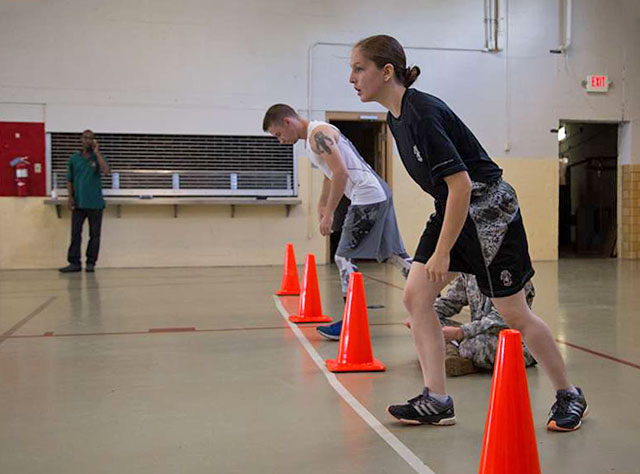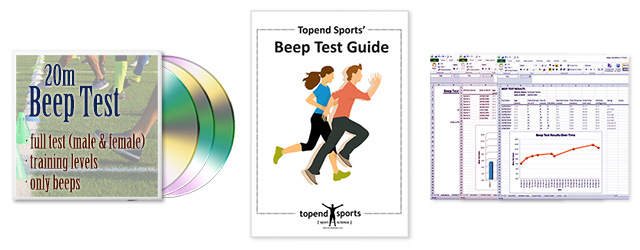There are many versions of the test commonly called the beep test, with small variations in test timings. The standard 20m test has evolved a little since it was first introduced in 1982. Depending on the source of the test, the test timings and distance used may vary a little.
History
The beep test was originally developed from the University of Montreal Track Test, an incremental continuous running aerobic fitness test conducted around a 400m running track, which followed audio cues that increased the pace every two minutes. The 20m shuttle run test evolved from this by reducing the space required and making it possible to perform the test indoors so that environmental conditions could be controlled. The original shuttle run test article by Léger and Lambert (1982) described a protocol of two-minute stages or levels, which was reduced to one-minute stages when published two years later (Léger et al. 1984).
Current Variations
Since the original paper describing the beep test by Léger and Lambert in 1982, there have been a few variations of the test published. Most of the test versions are very similar, though the names used to describe it may sound like they are very different tests. The test has been variously described as the beep or bleep test, multi-stage fitness test, MSFT, MST, 20 meter shuttle run test, yo-yo endurance test, PACER and Aero tests. In French it is called the 'Test de Luc-Léger'. Some people incorrectly call it the yo-yo test, which is a different test. (See more about what it is called) (POLL: What do you call it?)
 waiting for the beep test to start
waiting for the beep test to start It is important when you interpret the results of the test that you understand what version you are using and you should ensure that you have norms relevant to that version. For a comprehensive review of protocols, see the article by Tomkinson et al. (2003). As an example, the Beep Shuttles page lists the number of shuttles for two different versions of the test.
The protocol presented in the original study by Léger et al. (1984) starts at a speed of 8.5 km/hr and increases by 0.5 km/hr for each one-minute stage. Around the same time, the test protocol for the 20m shuttle test in the Eurofit Manual (1983) started at 8.0 km/hr, jumped up to 9.0 km/hr then 0.5 km/hr for each stage thereafter. Subsequently, there were versions following this which used one of these two versions. As this only affected the speeds of the early stages, and that starting speeds are quite slow, there is effectively no difference in the results from each of these protocols.
Differences Around the World
A version has been published by the British National Coaching Foundation, which is a variant to that originally described by Léger et al. (1984). Participants start at a speed of 8.0 km/hr, with the second stage at 9.0 km/hr, and thereafter there is an increase in speed by 0.5 km/hr each stage. The test is called the 'Bleep Test' in the UK. (see this Beep Table for details of each level).
The Australian Coaching Council (under the banner of the Australian Sports Commission) has produced two versions of the 20 meter shuttle run test, with one-minute stages (or levels). The speeds and levels of each version are the same. As in the British version mentioned above, the participants start at a speed of 8.0 km/hr, with the second stage at 9.0 km/hr, and thereafter there is an increase in speed by 0.5 km/hr each stage.
Out of Ireland came the Queen’s University of Belfast protocol (Riddoch, 1990), which is a hybrid of the two protocols above, starting at 8.0 km/hr and increasing by 0.5 km/hr for each one-minute stage. This is the same as the endurance version of the yo-yo test. Thanks to the detective work of Dan Ford, it appears that one of the iphone beep test apps uses this test protocol. You would expect to perform better using this protocol, as most stages are at a slower speed compared to the other protocols.
I was also sent a version that is being used in Canada, which starts at 8.5 km/hr and increases by 0.5 km/hr (as per the original by Luc-Léger, himself from Canada), though the test begins at zero stage, rather than stage or level 1. The recorded results are therefore off by one level compared to most other versions.
List of Variations
References (see more)
- Léger, L.A. and Lambert, J., 1982, 'A maximal multistage 20m shuttle run test to predict VO2max', European Journal of Applied Physiology, Vol 49, p1-5.
- Eurofit, (1983), Eurofit Tests of Physical Fitness, Strasbourg. Experimental Battery PROVISIONAL HANDBOOK.
- Léger, L.A., Lambert, J., Goulet, A., Rowan, C., & Dinelle, Y. (1984). Capacité aérobie des Québécois de 6 à 17 ans — test navette de 20 mètres avec paliers de 1 minute. Canadian Journal of Applied Sport Sciences, 9(2), 64-69.
- Riddoch CJ. (1990) The Northern Ireland health and fitness survey -1989: the fitness, physical activity, attitudes and lifestyles of Northern Ireland post-primary schoolchildren. Belfast: The Queen’s University of Belfast.
- Tomkinson, G.R., Léger, L.A., Olds, T.S., & Cazorla, G. (2003). Secular trends in the performance of children and adolescents (1980–2000): An analysis of 55 studies of the 20 m shuttle run in 11 countries. Sports Medicine, 33, 285–300.
Related Pages
- For a comprehensive listing of information about the Beep Test, see the Beep Test Home.
- List of Modified Beep Tests
- Can I do the beep test on a treadmill?
- Free download of the beep test mp3
- Videos of Beep Tests including many variations
- Alternatives to the beep test
- Maximizing Your Score — to get the most out of the beep test.
- Test Procedure — Detailed instructions for conducting the beep test. Also video examples.
- Calculating Your Score — calculator to determine your VO2max equivalent score.
- What it is called around the world?
- Purchasing the beep test cd
- What's your best score? some results of athletes.
- Beep Shuttle Listing — a table list of the number of shuttles for each level.
- Beep Test Software — provides the standard Multistage Fitness Test or Bleep Test right on your PC or Laptop, with many additional features.
BEEP TEST PACKAGE - only $10
The 20m Beep Test (male & female voices) + Training Levels + 'Beeps Only' track + Excel Spreadsheet + eBook Guide (PARQ, consent form, test recording sheet, warm-up, tips, norms + much more!)

The ultimate beep test package, including two versions of the beep test audio file (male and female voice), an audio track with only the beeps (no voices), 8 audio tracks for training at specific test levels, an Excel spreadsheet with an offline calculator and tables for recording, analyzing and presenting results, a 12-page eBook beep test guide which includes a PARQ, informed consent form, and test recording sheet plus much more. All these files are available individually for $5 each, or even better get them all for $10. Check out the details.


 Current Events
Current Events